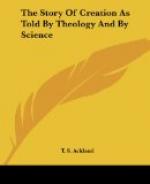These words carry us back to a time indefinitely remote. Eternity and Infinity are ideas which we cannot grasp, and yet we cannot avoid them. If we stretch our imagination to conceive of the most distant possible period of time—the farthest point of space— still we feel that there must have been something before the one, that there must be something beyond the other; and yet we cannot conceive of that which has no beginning, or no boundaries. The first verse marks out for us as it were a definite portion of this limitless ocean. “In the beginning,” is the point from which time begins to run—“the heavens and the earth,” the visible universe beyond which our investigations cannot extend. Whether other manifestations of God have taken place in Eternity, or other systems of worlds now exist in infinity, we are not told.
The heavens and the earth then are to be considered as comprising the visible universe, sun, moon, and stars, and their concomitants, which the eye surveys, or which scientific research brings to our knowledge. All are comprehended in this one group by Moses, and recent spectroscopic investigations teach us that one general character pervades the whole. Every star whose light is powerful enough to be analyzed, is now known to comprehend in its materials a greater or less number of those elementary substances of which the earth and the sun are composed. Whether any of these worlds were called into perfect existence at once, or whether they all passed through various stages of development, we are not told, that in some of them the process of development is only commencing, while in others various stages of it are in progress, is, as will be seen presently, highly probable. But the narrative takes no farther notice of anything beyond our own group of worlds, and proceeds to describe the condition of the earth (probably including the whole solar system) at the time at which it commences. Its words imply such a state of things as corresponds to what has been said in the preceding section of matter, apart from force. No better words could probably have been chosen for the purpose. The only word which seems to convey any definite idea is in the following clause, where water is mentioned. Until force was in operation water could not exist. Probably St. Augustine’s interpretation is the correct one—the confused mass is called alternately earth and water, because though it was as yet neither one thing nor the other, it contained the elements of both. And the word “water” expressed its plastic character. ("De Genesi ad Literam” Liber Imperfectus, Section 13, 14.)
One other important point in these words is, that they negative the eternal existence of matter. The second verse describes it as existing, because it had been called into existence at the bidding of an Almighty Creator, as described in the first verse.
Section 4. The first day.
“And the Spirit of God (was) brooding upon the face of the water.




